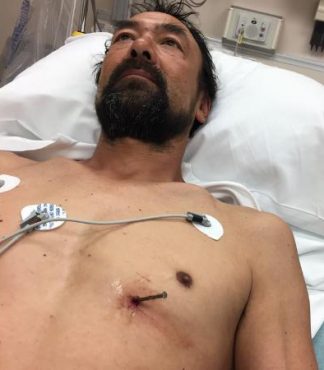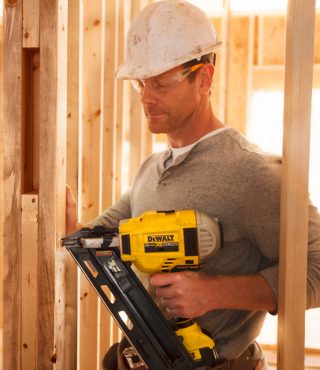
John Bleasby
Shot to the heart is a sharp reminder about nail gun safety
Canadian ContractorMan survives a 3 ½ inch nail driven into his chest
Doug Bergeson of Peshtigo, WI, an experienced construction worker, was installing a fireplace in his family’s home, standing on his tip-toes, using a double-fire nail gun, when the unthinkable happened. With one arm around the framing, Bergeson held the nail gun with the gun facing his body and only the wood in between. The first nail went into the wood, but the second one ricocheted and entered his chest.

Doug Bergeson awaits the removal of a nail to his heart
(photo: Donna Bergeson)
“Eight miles in it started to hurt quite a bit”
Bergson was lucky, and incredibly calm. The nail was sticking though his shirt, but he saw no blood. Smart enough at least not to try removing the nail, Bergeson dusted off his clothes, got in his truck and drove 12 miles the local medical center. “Eight miles in it started to hurt quite a bit,” he told local media later. Doctors told him after emergency surgery that the nail had entered his heart, and that he was mere centimetres from death. The nail stopped right before it would have made contact with an artery, which would have caused internal bleeding and the heart to stop pumping blood in two to three minutes, Bergeson said.
Safety trumps productivity
Contractors know that nail guns may be efficient but are lethal weapons. In fact, the U.S. Center for Disease Control (CDC) estimates that nail gun accidents result in about 37,000 emergency visits to medical centers in each year in that country alone. More than two-thirds of those injured are professionals.
Nail injury reduction starts with eliminating double-fire guns
The CDC has a number of recommendations that might drastically improve nail gun safety on the job site and result in fewer scary incidents like Bergeron’s. First on the list is recognizing the increased risks associated with double-fire nail guns. The CDC says the risks of accidents are twice as high compared to contact trigger guns. From a productivity standpoint, the any reduction in speed (if measurable) is worth the safety benefits.

Correct positioning is critical to safe nail gun operation
The CDC’s lists seven likely causes of nail gun injuries
1. Unintended nail discharge from double fire
2. Unintended nail discharge from knocking the safety contact with the trigger squeezed
3. Nail penetration through lumber work piece
4. Nail ricochet after striking a hard surface or metal feature
5. Missing the work piece
6. Awkward position nailing
7. Bypassing safety mechanisms
Six steps to reduce the risk of injury
The CDC goes further and offers this short list of preventative measures. They all make perfect sense; each measure can and should be a part of every contractor’s safety training plan.
1. Use full sequential trigger nail guns
2. Provide training
3. Establish nail gun work procedures
4. Provide personal protective equipment (PPE)
5. Encourage reporting and discussion of injuries and close calls
6. Provide first aid and medical treatment.
Where to go for more information
“Nail Gun Safety: A Guide for Contractors,” A useful guide for contractors
“Straight Talk About Nail Gun Safety,” A worker-focused information publication
Follow John on Instagram and on Twitter for notifications about his latest posts


Leave a Reply